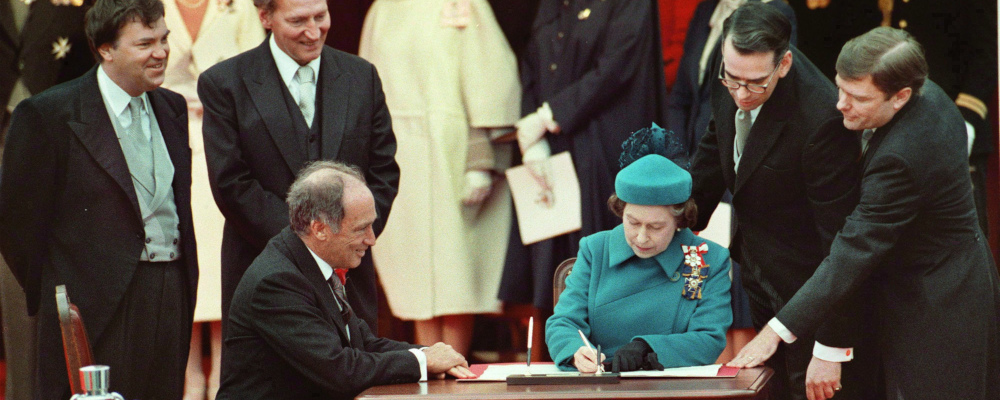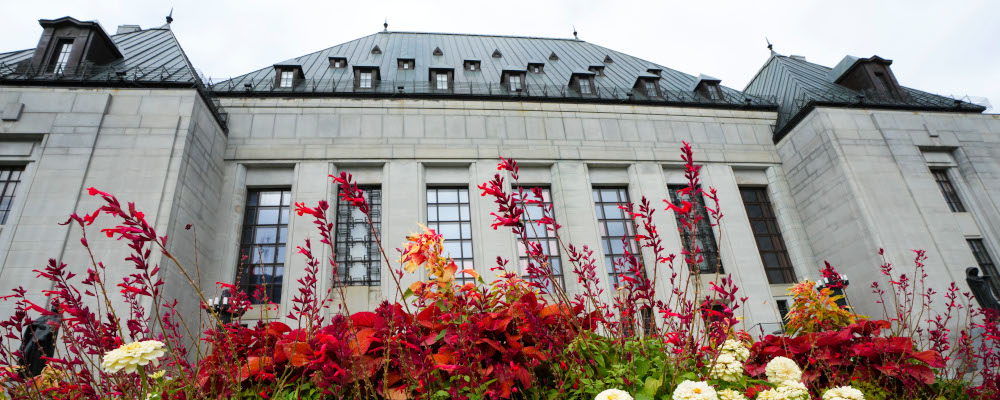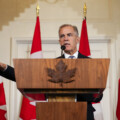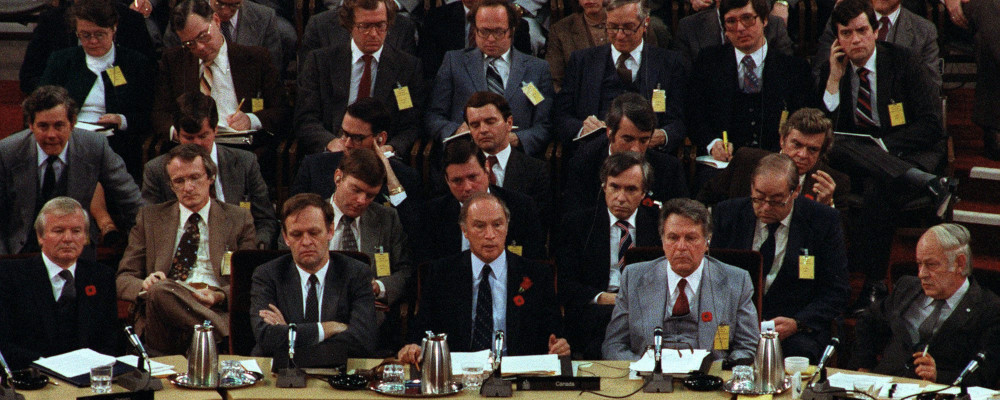Earlier this year, to mark the 40th anniversary of the patriation of the Canadian Constitution, UBC law professor Brian Bird wrote a four-part seriesThe Charter at Forty: The road to 1982 https://thehub.ca/2022-01-19/the-road-to-1982/ for The Hub tracing Canada’s constitutional history from Confederation to the present, ending with some thoughts about our constitutional future. It is an erudite and accessible journey through more than a century and a half of legal history, which I recommend to anyone interested in understanding the significance of 1982 as an inflection point in the modern history of Canada. In my own rather more polemical series, I make the case that by 1982 Pierre Trudeau’s constitutional vision, which was grounded in the Enlightenment values of liberal rationalism, was already outdated and that Canada’s new Constitution has thrived not on Trudeau’s intended terms, but as a broadly illiberal exercise of irrational judicial power.
The entire four-part series is published here in full.
Trudeau’s rational folly
With apologies to Virginia Woolf, on or about June 1967, human nature changed. As with the birth of modernism observed by Woolf, “[t]he change was not sudden and definite … [b]ut a change there was, nevertheless” and “when human relations change there is at the same time a change in religion, conduct, politics, and literature.” So it was in the Summer of Love.
It was one of those moments in history when a subculture becomes a zeitgeist. The communal flophouses of San Francisco, so grimly chronicled by Joan Didion and Tom Wolfe, may have been the most unlikely place for a cultural revolution since the rat-infested cafes of Paris’s Latin Quarter, but that is where the eyes of the world alighted in 1967 and they remained there long enough to imprint permanently a psychedelic distortion of reality onto the Western consciousness.
The climax of this cultural moment was the Monterey Pop Festival, which ran from June 16-18. John Phillips wrote the flower-child anthem “San Francisco (Be Sure to Wear Flowers in Your Hair)” for the festival. The song begins with a dreamy invitation to join the “gentle people with flowers in their hair” in a summertime love-in, but then abruptly shifts to an urgently prophetic voice, proclaiming that “all across the nation…there’s a new generation with a new explanation.” The singer promises not just floral reverie but “people in motion,” a generation on the march.
Almost exactly one year later, on June 25, 1968, Pierre Trudeau became Prime Minister of Canada. In the Canadian mythopoetic imagination, the two events—Trudeaumania and the 1960s counterculture—are usually linked, but with the benefit of distance we can see that Trudeau was an unlikely and unconvincing avatar of the 1960s.
Trudeau was no hippie. Like his near contemporary, John F. Kennedy (who, had he lived, would have loathed the hippies), he was a well-preserved relic of the world the young baby boomers sought to wash away in a trippy haze of peace, love, and sandalwood. He was a balding lawyer, older than most of their parents, and he wore his flowers in his tailored lapel rather than in his thinning hair. Far from being a new-age spiritualist or a cosmic thinker, he was a Catholic who believed in reason and its promise of scientific and social progress. About the only thing he had in common with the hippies was the age of his girlfriends.
The confusion, which was there from the beginning, is understandable. Because Trudeau’s liberalism shared many of the emancipatory goals of the younger generation—most obviously the overthrow of sexual mores (hippies, in the name of free love against repression; liberals in the name of reason against irrational tradition)—it was easy to see them as part of a common project. In fact, they were two branches of the Enlightenment that were diverging so rapidly that the newer one was turning back on the other, not to reinforce it but to devour it.
The hippies shone the light of Enlightenment skepticism back on its own premises and found a void at the heart of liberalism. Whether Trudeau realized it or not, by 1968 the Age of Reason had met its backlash in the Age of Aquarius and was on the way out. The tension between his faith in “La raison avant la passion” and the tuned-in and turned-on generation who believed in magic and good vibrations could be ignored as long as they were both sweeping tradition and convention before them. But the underlying philosophical divide was real. It was exposed most memorably during the FLQ crisis when Trudeau made it clear he had no time for bleeding hearts when they got in the way of his tanks.
Trudeau’s political project, which he had been developing in the pages of Cité Libre since the 1950s, could not have been more different than the consciousness-raising revolution of the 1960s dropouts. Unlike the hippies, who sought transcendence in the intentional irrationalism of mind-altering psychedelics, spiritualism, and ersatz Eastern mysticism, Trudeau still believed in objective truth knowable through reason. So much so that he worked with law professor Barry Strayer for more than a decade to develop a modern constitutionalism for Canada grounded in a belief that politics could be rationally ordered and directed under the supervision of neutral, apolitical judges.
It is hardly spoiling the end of the story to reveal that this is not what happened. With ultimate responsibility transferred a few hundred yards down Wellington Street from Parliament to the Supreme Court, the Canadian Constitution began to evolve apart from, and with only indirect influence from, the political work necessary to hold together an irrational society.
After 40 years of such hothouse evolution, Canada’s legal Constitution now resembles an exotic cultivar bred by an eccentric recluse. Like Des Esseintes’ flowers in A Rebours, the “living” Constitution often appears more artificial than alive, as befits a form of government driven by a liberal rationalism that is not naturally and organically tied in theory or practice to the social reality of custom, morality, and public expectation.

A Constitution out of time
Trudeau may have thought that by adopting the American idea of rights-based liberal constitutionalism he would usher in a new era of rational politics, but it was a belated attempt to convert Canada to a dying faith. Trudeau’s tenacious political longevity meant that, by 1982, he was a man out of his time—a liberal true-believer in a society fractured by the logical consequences of liberalism’s doctrine of radical autonomy. Yes, there were constitutions modeled along American and Canadian lines after 1982, but they were mostly flawed or superficially formal imitations of the originals. Some were exercises in liberal imperialism, imposed in a spirit of guilty hope on newly liberated colonies; most were constitutional kitsch.
Canada’s own Constitution was enacted at just about the last moment at which it would have been possible to do so here. Politically, the logic of individual autonomy that underlay Trudeau’s liberalismEarlier this year on this site, UBC Law Professor Brian Bird recorded that, in his memoirs, Trudeau described the Charter as “an expression of my long-held view that the subject of law must be the individual human being; the law must permit the individual to fulfill himself or herself to the utmost.” was beginning to reveal its destructive potential as it fractured the social consensus at a much deeper level than even he intended. One obvious consequence of this was Quebec’s rejection of the new Constitution—an act of defiant self-determination that drew on the same liberationist impulse that underlay Trudeau’s Charter, albeit at the national rather than the individual level. Liberalism had no answer to a movement that used its freedom to reject liberalism.
The demand for recognition and autonomy didn’t end with Quebec. Just eight years after the new Constitution was enacted, Elijah Harper refused to grant unanimous consent to the Meech Lake Accord in the Manitoba legislature. His stand showed that Indigenous Canadians were no longer content to be passive observers of other peoples’ acts of constitutional self-creation. Just two years later, the Charlottetown Accord was rejected by a majority of the provinces and territories as the country divided over the question of whether Quebec’s distinct status should be constitutionally recognized as an atavistic anomaly within the new liberal order.
By 1991, the consensus that had been strong enough in 1982 to allow Trudeau and the premiers to impose the new Constitution as a top-down fait accompli was shattered. It is likely that, even in 1982, if the people of Canada had been asked for their opinion on each article of the proposed Constitution, the process would have disintegrated in the same way it did in the Meech Lake and Charlottetown debacles. But back then, governments could just about get away with not asking the people. Less than a decade later, as Peter C. Newman wrote, it was clear to most Canadians “that 11 men in suits meeting behind closed doors should never again determine the country’s future.”
To understand how revolutionary Trudeau’s Constitution was, you have to start with the Constitution it replaced.British North America Act, 1867 – Enactment no. 1 https://www.justice.gc.ca/eng/rp-pr/csj-sjc/constitution/lawreg-loireg/p1t11.html Although the British North America Act of 1867 exhibited what constitutional theorist Martin Loughlin calls “the incipient Rationalism of writtenness,” its written terms mostly specified the division of powers in a confederal state and the peculiar requirements of accommodating previously separate colonies. When it came to the operation of government, however, it followed the unwritten practices, customs, and conventions of Victorian parliamentary democracy, which meant parliamentary supremacy—or at least as close an approximation of such power as an Imperial statute could permit. It even specified that Canada would have “a Constitution similar in Principle to that of the United Kingdom,” which meant an implicit, organic, often unstated, and stubbornly anti-Rational Constitution.
Our pre-1982 Constitution was not based on the liberal theory of authority delegated by the people but rather, as Leo Amery observed of the British Constitution in the 1940s, on “democracy by consent and not by delegation, of government of the people, for the people, with, but not by, the people.”My emphasis. Trudeau’s reforms went right for that pre-Enlightenment heart, injecting the adrenaline of the American and French revolutions into our sleepy constitutional compromise. For the first time in a Westminster parliamentary system, a layer of universal rights was elevated in an unspecified and abstract form—with the details to be worked out later—above the sovereignty of parliament. How alien was the new Constitution? Consider that it introduced the principle of judicial supremacy into a Constitution that didn’t (and still doesn’t) strictly require there to be a Supreme Court of Canada.
The idea of subordinating local custom, tradition, public morality, and practical knowledge to the “Rights of Man” was the apotheosis of the Enlightenment project. As Yuval Levin described it in his book contrasting the philosophies of Thomas Paine and Edmund Burke, the Rationalists insisted that “[e]very political practice, institution and allegiance must explain itself in philosophical terms, so that no long-standing tradition, institution or cherished habit can resist the searing light so speculative analysis.” In theory, the Charter summed up the utopian idealism of the liberal imagination and nothing as prosaic as the wisdom of the ages would be allowed to stand in its way. In practice, it threw the form of the Constitution up for grabs, and it was the judges who grabbed it.
In the hands of courts with almost total power to circumscribe the power of the other branches of government, the liberalism that Trudeau believed should order society quickly slipped its chain. Canada’s courts began applying the relentless logic of liberal rationalism to every belief system except, of course, liberalism itself. In case after case, the courts applied it to reject, as Levin wrote of the liberal project in general, “all that cannot explain itself in terms of modern reason” and to retain “only those elements of political life that meet its standards—regardless of what society may actually need or that had proven capable of serving the community in years gone by.”
The Supreme Court of Canada constitutionally entrenched this legal philosophy in the 1986 case of R. v. Oakes, when it announced that every act of parliament must now be rationally justified as “proportional” to the satisfaction of the courts. Under the Oakes test, an act of parliament must be directed at a necessary and important goal and “proportionate” in the rational means by which it would achieve that goal—with the courts sitting as the arbiters of what political ends are necessary and which political means are rational for the government of Canadian society.
It is a test that might have been dreamt up by Paine himself. And like Paine’s philosophy of deracinated capital-R Reason, once unleashed, it could not be contained. Henceforth, the Constitution would no longer take its meaning from settled expectations, social convention, and moral intuition as expressed democratically through parliamentary deliberation but from the creative reasoning of the courts, subject only to the apparently inexhaustible limits of their creativity.
In 1968, the witty old leftist theorist of the British Constitution, JAG Griffith, summed up a similar tendency in the (much more modest and restrained) jurisprudence of his country. The judges, he wrote, “say and believe that distinctions can be made between matters apt for the courts, and matters apt for Parliament. They render to Caesar the things that are Caesar’s and to themselves the things that are God’s.” After 1982, Canada’s Supreme Court may not quite have claimed absolute divine authority but, taking the adjective “supreme” rather too literally, they confidently assumed absolute temporal power.

The revolution no one asked for
It is not clear how much of the constitutional change that Canada has experienced since 1982 Pierre Trudeau anticipated, or whether his constitutional revolution took on a life of its own as revolutions tend to do. He may have been naïve enough to think that, contrary to almost all exercises of unchecked power in history, his new liberal rationalist constitution would be contained by the judges charged with interpreting and applying it.
There is some evidence that he believed that courts would use their newfound powers only to rein in the most extreme excesses of the democratic spirit, but not to pre-empt democratic debates over social policy. In 1981, while the Constitution was still under consideration, Trudeau wrote to Cardinal Carter, the then-Archbishop of Toronto, to assure him that Canadian courts would not be able to discover an implicit right to abortion in the Charter’s vague guarantee of “life, liberty, and security of the person,” as the U.S. Supreme Court had recently done in their Bill of Rights.
Trudeau wrote that he believed it was right that “the Charter should remain neutral on the issue, leaving it to be debated and resolved from time to time in Parliament rather than before the courts.” In a subsequent letter to the Cardinal, Trudeau insisted that “the Charter is absolutely neutral on the issue of abortion” and that this was also “the interpretation of senior officials and agents of the Department of Justice and…the Minister himself.”
He added that, if a court ever did overstep and presume to decide questions of social policy, “Parliament will continue to legislate on the matter by overriding the court’s decision.” It is possible that Trudeau was dissembling, but I don’t think so. He was a serious Catholic and unlikely to commit himself on official letterhead—and to a Prince of the Church, no less—to such deception.
Whatever Trudeau’s intentions, the liberal constitutional project proceeded in Canada along the same lines it had in the United States and for the same reason: once the liberal conception of rights as claims against society is introduced into a political order, it cannot be contained to discrete and defined areas of law or public policy. Because it claims the authority of a universal principle, it must spread and occupy every corner of society, colonising our speech and even how we think about every question of law and morality up to and including questions of life and death. It runs riot over society’s settled expectations under the banner of reason.
Yes, defenders of the new order reply, judges now have the power to apply a rational lens to the policy that emerges from parliament, and who could object to that? Objecting to rational supervision of the law would be per se unreasonable. And who would support unreasonable policies? This way of thinking is wrong in three ways.
First, it assumes that judicial rationality is, in fact, objectively reasonable. In practice, it has more often been the imposition of a liberal ideology that views rights as one-way claims by individuals against society, rather than beginning with an idea of the common good and determining what is properly owed to a person or to a group within that socially-embedded context. At best, the current approach to judicial review is a contestable ideological choice, and by no means the best one.
Second, it assumes the problems that judges are taking up are capable of definitive political answers. But questions like assisted suicide (Carter v. Canada), Sunday closing laws (R. v. Big M Drug Mart Ltd.), and prisoner voting (Sauvé v. Canada) are not so easily resolved, and especially not by pretending they can be decided objectively by legal reasoning. It is not surprising that each of these questions has been decided differently by the courts in peer countries. They involve moral choices, and the Canadian Supreme Court’s approach to rights, which prioritises near-absolute individual autonomy, is not the only—or, in some cases, even a—viable moral choice. These choices are the stuff of politics, not law, because they are the choices we make to decide who we are as a people and how we define the character of our polity.
Third, not only are judges not trained in (or chosen for their) moral and political reasoning, it is not clear why, even if they were, we should prefer to be subjected to the unreviewable reasoning of judges than the reviewable reasons of elected representatives. Surely, when it comes to questions of life and death, it is at least plausibly rational to prefer the risk of political error that can be corrected politically over the risk of incorrigible judicial error. That seems to have been Trudeau’s view when he contemplated the possibility that courts might be tempted to assume oversight of social policy in his letters to Cardinal Carter. As it turns out, he had too much faith that rationality could be rationally contained.
Shortly after the new Constitution was enacted, the Supreme Court of Canada signalled its intent to break with the expectations of the democratic bodies that enacted it as well as with the method of developing the law case by case in a way that reinforced existing social practices and norms.See Reference re Section 94(2) of the Motor Vehicle Act (1985). Instead, it would look to international constitutional courts and to an outpouring of new homegrown academic theories for more radical inspiration. The most consequential and enduring example of this was the adoption of the German legal model of proportionality review in the 1986 case of R. v. Oakes.
The Oakes test, which was introduced in the second part of this series, marked the end of Trudeau’s liberal dream. The principle of proportionality that it introduced, while purporting to be a rigorously rational method of adjudication, undermined the new Constitution’s rational pretensions. Because it leaves the key decisions to individual judges, no matter how well-intentioned and serious a judge is, when the method is applied to pre-rational custom or contestable moral questions the outcome is unavoidably subjective.
The legitimacy of liberal constitutionalism depends on its claim that courts are justified in ensuring that society is rationally ordered, even to the point of nullifying the ostensibly reasoned decisions of elected and accountable legislatures. This claim, in turn, is based on the assumption that the courts’ decisions are based on a superior objective rationality. But if the decision-making process at the heart of liberal constitutionalism is itself irrational, then the whole system is compromised.
A success, but on whose terms?
Defenders of the Canadian Constitution believe that its liberal principles are the best—and probably the only—way to accommodate differences of political opinion in a post-modern society Or, perhaps, “liquid modern” society. and to reconcile the interests of minorities and majorities. For this to work, they say, we need the courts constantly tugging and prodding governments to adhere to these liberal principles, even if that means limiting the scope of political choice in the democratic process and removing some controversies from the political sphere altogether.In practice, those controversies that the polity stubbornly refuses to resolve once and for all along the lines preferred by liberal philosophy or neoliberal interests. Their argument assumes, of course, that the process of judicial review that we currently have is itself rational. It is not.
In Canada, courts reviewing legislation apply what is called the principle of proportionality, which it first announced and framed in the 1986 case of R. v. Oakes.See parts two and three of this series for more discussion and background. Briefly stated, proportionality requires that a law furthering an important social goal must not limit a protected right more than is necessary to achieve that goal. To do this, the court applies a three-part balancing test.The test is variously described as having three or four parts. A standard statement of it can be found here.
First, the law must be rationally connected to the important and necessary (“pressing and substantial”) objective the government wants to achieve. Second, the law must be likely to achieve its objective in a way that minimally limits protected rights. Finally, the law must be proportionate stricto senso (“in a strict sense”). That is, the government must strike the right balance between limiting protected rights and furthering social goods.
This all sounds good in theory; the problem is that, in reality, it’s a little more complicated. Those of you who escaped indoctrination into the cult of proportionality at law school may have noticed a niggling flaw in the method described above: the metrics are essentially arbitrary. The relative weights of benefit and harm are not fixed by a common and objective standard. The judge has no yardstick by which to measure the limitation of an individual right (on the one hand) and the diffuse benefits of the law to the common good (on the other). This is called the incommensurability problem, or the impossibility of comparing fundamentally different goods.
The incommensurability problem has been illustrated by the challenge of being asked to choose the fastest car at the lowest price: which car you choose will depend on how much value you choose to assign to speed and how much to price. Those choices are, if not exactly arbitrary, invariably subjective. There is not only no right or wrong answer, one can’t even say that there are better or worse answers.
This makes the incommensurability problem a different challenge entirely than the proverbially difficult comparison of apples and oranges; compared with the hardest questions of law and public policy, apples and oranges are actually comparable along many lines (size, price, colour, ripeness). Courts will sometimes attempt to turn the incommensurability problem into a relatively more soluble “apples and oranges” problem by describing both individual rights and public goods using a neutral term, just as price can be used to compare different fruits.
For example, a court may refer to both rights and goods as “interests” and then weigh the competing “interests” against another. But this doesn’t solve the problem; it avoids it.Using price to compare apples and oranges may also avoid the problem of comparison if price is not a contextually relevant measure, but it is at least an objective standard. This kind of proportionality analysis “succeeds” only by distorting the nature of both individual rights and the common good. Calling rights mere personal “interests” neuters their moral force, and reducing the public good to a social “interest” misunderstands the purpose of government. In any event, the distortions are in vain. A judge can still only pretend to balance these illusory interests on an imaginary scale.
Even if one could establish a common metric for both individual rights and public goods, how would you start to assign weights to each side of the equation so that they could be usefully compared? Each judge must do this according to his or her personal judgement. Although most judges do this in good faith and with the best of intentions, the inherent subjectivity of the exercise explains why panels of judges so often disagree in Charter cases, despite working from the same facts and law. Proportionality, in practice, provides only illusory escape from the hard business of governing. Constitutional balancing tests “solve” the incommensurability problem in hard cases by producing judgements that are, as legal scholar Richard Ekins has written, “underdetermined by reason.”R Ekins, “Legislating Proportionally” in G Huscroft, B Miller and G Webber, Proportionality and the Rule of Law (CUP 2014).
“[Trudeau] had too much faith that rationality could be rationally contained.”
As a rough and ready heuristic for political decision-making, the idea of proportionality is helpful, but it can’t escape the fact that governing requires us to make decisions involving incommensurable interests, immeasurable effects, and unknowable outcomes. The degree to which these things are incommensurable, immeasurable, and unknowable in a specific case will vary, but only in the easiest of cases will there be clear answers that most reasonable people can agree on—and we do not need courts for easy cases.
For the hard cases, a society needs a decision-making process intimately attuned to its unique pre-political religious and moral intuitions, stories and legends, social structures, geographic pressures, and economic organisation. One can imagine different forms of government that could do this; none would look like a courtroom under the formal constraints of modern litigation.
We had such a system of government before 1982, and we could have had a modified but still recognizable version after 1982 if the courts had chosen a path of self-restraint. When this alternative is put to Canadian judges, however, the most common response is a shrug and a half-hearted protest that amounts to: “We didn’t choose the powers the new constitution gave, and we can’t simply choose not to exercise them.”Three examples among many will suffice. “Beverley McLachlin on her controversies, activism, Supreme Court legacy” (CBC interview with Rosemary Barton, Dec 17, 2017) (“But the fact is [the Charter] became the law of the land. It became the Constitution, and the judiciary had no choice but to uphold that law.”); Rt Hon Beverley McLachlin, “Respecting Democratic Roles” (Speech, Nov 22, 2004) (“Where a legal issue is properly before a court, not deciding is not an option.”); Vriend v. Alberta, 1998 (“[I]t should be emphasized again that our Charter’s introduction and the consequential remedial role of the courts were choices of the Canadian people through their elected representatives as part of a redefinition of our democracy. … So courts in their trustee or arbiter role must perforce scrutinize the work of the legislature and executive not in the name of the courts, but in the interests of the new social contract that was democratically chosen. All of this is implied in the power given to the courts under s. 24 of the Charter and s. 52 of the Constitution Act, 1982.”) Hand-waving at “all of this”—by which Justice Iacobucci includes many specific and not at all obvious jurisprudential choices and precedents—and blaming the democratic bodies that empowered the courts rather than the choices the courts made in exercising that power, hardly qualifies as a justification. It is the intellectual equivalent of a policeman clubbing an innocent bystander shrugging and saying “well, I was empowered to enforce the law.” But they did and they still could.
The adoption of the Oakes test and proportionality review was not pre-ordained; it was a choice. So was the decision to reject the more obvious procedural meaning of “principles of fundamental justice” in favour of interpreting it as a new judicial authority to impose new substantive limits on parliament’s legislative power. And so were the cramped reading of Section 1’s “reasonable limits” that clipped parliament’s wings and, later, the expansion of the already-stretched limits of Charter rights to include an obscure penumbra of “Charter values.” Each of these was a choice that took us further from the old Constitution but also, ironically, further from Trudeau’s vision.
Sometime between 1789 and 1968, the children of the Enlightenment lost their faith. As with Woolf’s diagnosis of Modernism in 1910, the change “was not sudden and definite,” but in hindsight, we can see that by 1982 that our society was badly fractured. The Enlightenment belief in progress and trust in science to guide (rather than serve) society had mostly evaporated. The corrosive logic of liberalism had dissolved the ancient bonds of family, culture, and religion, leaving a residue of confusion waiting for a new order to be born.
That was the moment Pierre Trudeau chose to enact his rationalist Constitution. It was a bold gambit, and a naïve one. To the extent it has succeeded it has done so, ironically, through an irrational exercise of judicial power that he should have predicted but almost certainly did not intend. Nevertheless, Trudeau’s constitutional legacy remains broadly popular. This is partly because it is ferociously defended by the powerful interests it serves, but mostly because, until we better understand our still-inchoate post-rational, post-liberal present, it feels safer than the alternative. For most of us, an anachronistic vision is better than no vision.
Recommended for You

‘Justin Trudeau was more in favour of coastal pipelines’ than Mark Carney: Jason Kenney on the federal government allowing B.C. to block national projects

Interprovincial pipelines fall under federal responsibility, former Alberta premier reminds B.C. and Ottawa

Premier Ford is Canada’s cartoonish Mayor Quimby

Need to Know: The Free Press is an independent media success story—but could it have happened in Canada?




